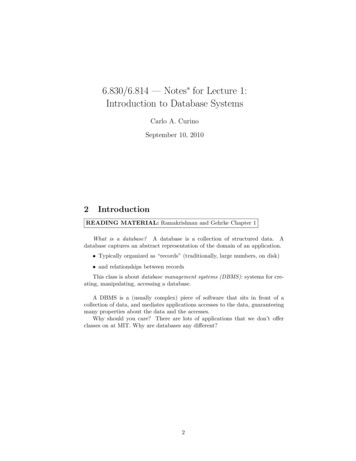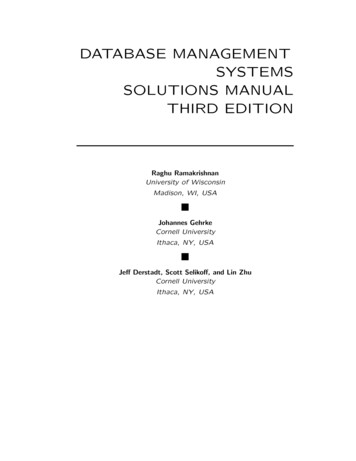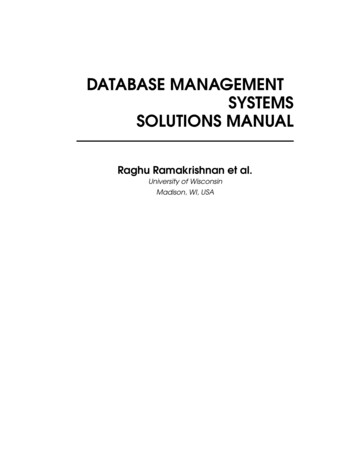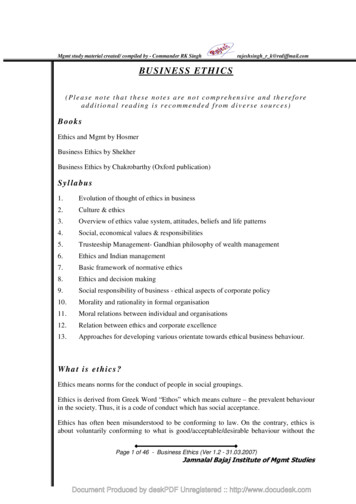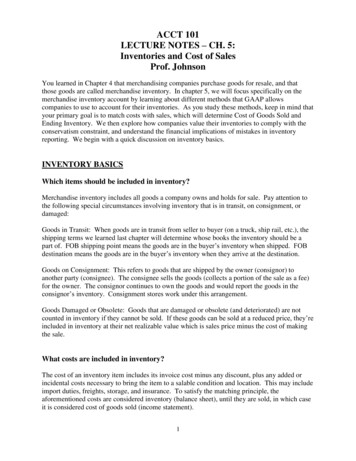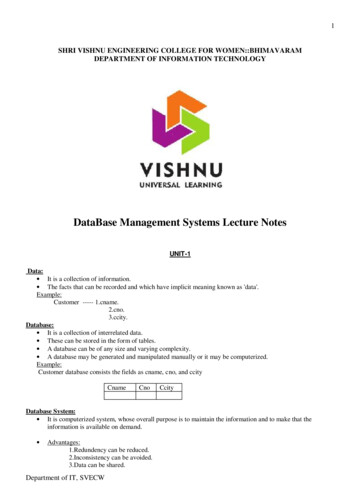
Transcription
1SHRI VISHNU ENGINEERING COLLEGE FOR WOMEN::BHIMAVARAMDEPARTMENT OF INFORMATION TECHNOLOGYDataBase Management Systems Lecture NotesUNIT-1Data:It is a collection of information.The facts that can be recorded and which have implicit meaning known as 'data'.Example:Customer ----- 1.cname.2.cno.3.ccity.Database:It is a collection of interrelated data.These can be stored in the form of tables.A database can be of any size and varying complexity.A database may be generated and manipulated manually or it may be computerized.Example:Customer database consists the fields as cname, cno, and ccityCnameCnoCcityDatabase System:It is computerized system, whose overall purpose is to maintain the information and to make that theinformation is available on demand.Advantages:1.Redundency can be reduced.2.Inconsistency can be avoided.3.Data can be shared.Department of IT, SVECW
24.Standards can be enforced.5.Security restrictions can be applied.6.Integrity can be maintained.7.Data gathering can be possible.8.Requirements can be balanced.Database Management System (DBMS):It is a collection of programs that enables user to create and maintain a database. In other words it is general-purposesoftware that provides the users with the processes of defining, constructing and manipulating the database forvarious applications.Disadvantages in File ProcessingData redundancy and inconsistency.Difficult in accessing data.Data isolation.Data integrity.Concurrent access is not possible.Security Problems.Advantages of DBMS:1.Data Independence.2.Efficient Data Access.3.Data Integrity and security.4.Data administration.5.Concurrent access and Crash recovery.6.Reduced Application Development Time.ApplicationsDatabase Applications:Banking: all transactionsAirlines: reservations, schedulesUniversities: registration, gradesSales: customers, products, purchasesOnline retailers: order tracking, customized recommendationsManufacturing: production, inventory, orders, supply chainHuman resources: employee records, salaries, tax deductionsPeople who deal with databasesMany persons are involved in the design, use and maintenance of any database. These persons can beclassified into 2 types as below.Actors on the scene:The people, whose jobs involve the day-to-day use of a database are called as 'Actors on the scene',listed as below.1.Database Administrators (DBA):The DBA is responsible for authorizing access to the database, forCoordinating and monitoring its use and for acquiring software and hardware resources as needed.These are the people, who maintain and design the database daily.DBA is responsible for the following issues.Department of IT, SVECW
3a. Design of the conceptual and physical schemas:The DBA is responsible for interacting with the users of the system to understand what data is tobe stored in the DBMS and how it is likely to be used.The DBA creates the original schema by writing a set ofdefinitions and isPermanently stored in the 'Data Dictionary'.b. Security and Authorization:The DBA is responsible for ensuring the unauthorized data access is not permitted.The granting of different types of authorization allows the DBA to regulate which parts of thedatabase various users can access.c. Storage structure and Access method definition:The DBA creates appropriate storage structures and access methodsby writing a set of definitions, which are translated by the DDL compiler.d. Data Availability and Recovery from Failures:The DBA must take steps to ensure that if the system fails, users can continue to access as muchof the uncorrupted data as possible.The DBA also work to restore the data to consistent state.e. Database Tuning:The DBA is responsible for modifying the database to ensure adequatePerformance as requirements change.f. Integrity Constraint Specification:The integrity constraints are kept in a special system structure that is consulted by the DBAwhenever an update takes place in the system.2.Database Designers:Database designers are responsible for identifying the data to be stored in the database and for choosing appropriatestructures to represent and store this data.3. End Users:People who wish to store and use data in a database.End users are the people whose jobs require access to the database for querying, updating and generating reports,listed as below.a. Casual End users:These people occasionally access the database, but they may needtime.different information eachb. Naive or Parametric End Users:Their job function revolves around constantly querying and updating the database usingstandard types of queries and updates.c. Sophisticated End Users:These include Engineers, Scientists, Business analyst and others familiarize to implement theirapplications to meet their complex requirements.d. Stand alone End users:These people maintain personal databases by using ready-made program packages that provideeasy to use menu based interfaces.4.System Analyst:These people determine the requirements of end users and develop specifications for transactions.5.Application Programmers (Software Engineers):These people can test, debug, document and maintain the specified transactions.Department of IT, SVECW
4b. Workers behind the scene:Database Designers and Implementers:These people who design and implement the DBMS modules and interfaces as a software package.2.Tool Developers:Include persons who design and implement tools consisting the packages for design, performance monitoring,and prototyping and test data generation.3.Operators and maintenance personnel:These re the system administration personnel who are responsible for the actual running and maintenance of thehardware and software environment for the database system.3.LEVELS OF DATA ABSTRACTIONThis is also called as 'The Three-Schema Architecture’, which can be used to separate the user applicationsand the physical database.1.Physical Level:This is a lowest level, which describes how the data is actually stores.Example:Customer account database can be described.2.Logical Level:This is next higher level that describes what data and what relationships in the database.Example:Each recordtype customer recordcust name: sting;cust city: string;cust street: string;end;3.Conceptual (view) Level:This is a lowest level, which describes entire database.Example:All application programs.4.DATA MODELSThe entire structure of a database can be described using a data model.A data model is a collection of conceptual tools for describingData models can be classified into following types.1.Object Based Logical Models.2.Record Based Logical Models.3.Physical Models.Explanation is as below.1.Object Based Logical Models:These models can be used in describing the data at the logical and view levels.These models are having flexible structuring capabilities classified into following types.a) The entity-relationship model.b) The object-oriented model.c) The semantic data model.d) The functional data model.2.Record Based Logical Models:These models can also be used in describing the data at the logical and view levels.These models can be used for both to specify the overall logical structure of the database and a higher-leveldescription.These models can be classified into,Department of IT, SVECW
51. Relational model.2. Network model.3. Hierarchal model.3. Physical Models:These models can be used in describing the data at the lowest level, i.e. physical level.These models can be classified into1.Unifying model2.Frame memory model.UNIT-2History of Database Systems1950s and early 1960s: Data processing using magnetic tapes for storage Tapes provide only sequential access Punched cards for inputLate 1960s and 1970s: Hard disks allow direct access to data Network and hierarchical data models in widespread use Ted Codd defines the relational data model Would win the ACM Turing Award for this work IBM Research begins System R prototype UC Berkeley begins Ingres prototype High-performance (for the era) transaction processing1980s: Research relational prototypes evolve into commercial systems SQL becomes industrial standard Parallel and distributed database systems Object-oriented database systems1990s: Large decision support and data-mining applications Large multi-terabyte data warehouses Emergence of Web commerce2000s: XML and XQuery standards Automated database administrationEntity Relational Model (E-R Model)The E-R model can be used to describe the data involved in a real world enterprise in terms ofobjects and their relationships.Uses:These models can be used in database design.It provides useful concepts that allow us to move from an informaldescription to precise description.This model was developed to facilitate database design by allowing the specification of overall logical structureof a database.It is extremely useful in mapping the meanings and interactions of real world enterprises onto a conceptualschema.These models can be used for the conceptual design of databaseapplications.1. OVERVIEW OF DATABSE DESIGNThe problem of database design is stated as below.Department of IT, SVECW
6'Design the logical and physical structure of 1 or more databases to accommodate the information needs ofthe users in an organization for a defined set of applications'.The goals database designs are as below.1.Satisfy the information content requirements of the specified usersand applications.2.Provide a natural and easy to understand structuring of theinformation.3.Support processing requirements and any performance objectivessuch as 'response time, processing time, storage space etc.ER model consists the following 3 steps.a. Requirements Collection and Analysis:This is the first step in designing any database application.This is an informal process that involves discussions and studies and analyzing the expectations of the users& the intended uses of the database.Under this, we have to understand the following.1.What data is to be stored n a database?2.What applications must be built?3.What operations can be used?Example:For customer database, data is cust-name, cust-city, and cust-no.b. Conceptual database design:The information gathered in the requirements analysis step is used to develop a higher-level description ofthe data.The goal of conceptual database design is a complete understanding of the database structure, meaning(semantics), inter-relationships and constraints.Characteristics of this phase are as below.1.Expressiveness:The data model should be expressive to distinguish different types of data, relationships andconstraints.2.Simplicity and Understandability:The model should be simple to understand the concepts.3.Minimality:The model should have small number of basic concepts.4.Diagrammatic Representation:The model should have a diagrammatic notation for displaying the conceptual schema.5.Formality:A conceptual schema expressed in the data model must represent a formal specification of the data.Example:Cust name : string;Cust no: integer;Cust city : string;c. Logical Database Design:Under this, we must choose a DBMS to implement our database design and convert the conceptual databasedesign into a database schema.The choice of DBMS is governed by number of factors as below.1.Economic Factors.2.Organizational Factors.Explanation is as below.Department of IT, SVECW
71.Economic Factors:These factors consist of the financial status of the applications.a. Software Acquisition Cost:This consists buying the software including language options such as forms, menu, recovery/backupoptions, web based graphic user interface (GUI) tools and documentation.b. Maintenance Cost:This is the cost of receiving standard maintenance service from the vendor and for keeping the DBMSversion up to date.c. Hardware Acquisition Cost:This is the cost of additional memory, disk drives, controllers and a specialized DBMS storage.d. Database Creation and Conversion Cost:This is the cost of creating the database system from scratch and converting an existing system to the newDBMS software.e. Personal Cost:This is the cost of re-organization of the data processing department.f. Training Cost: This is the cost of training for Programming, Application Development and Database Administration.g. Operating Cost:The cost of continued operation of the database system.2.Organizational Factors:These factors support the organization of the vendor, can be listed as below.a. Data Complexity:Need of a DBMS.b. Sharing among applications:The greater the sharing among applications, the more the redundancy among files and hence the greater theneed for a DBMS.c. Dynamically evolving or growing data:If the data changes constantly, it is easier to cope with these changes using a DBMS than using a filesystem.d. Frequency of ad hoc requests for data:File systems are not suitable for ad hoc retrieval of data.e. Data Volume and Need for Control:These 2 factors needs for a DBMS.Example:Customer database can be represented in the form of tables or diagrams.3. Schema Refinement:Under this, we have to analyze the collection of relations in our relational database schema to identify thepotential problems.4.Physical Database Design:Physical database design is the process of choosing specific storage structures and access paths for thedatabase files to achieve good performance for the various database applications.This step involves building indexes on some tables and clustering some tables.The physical database design can have the following options.1.Response Time:This is the elapsed time between submitting a database transaction for execution and receiving aresponse.2.Space Utilization:This is the amount of storage space used by the database files and their access path structures ondisk including indexes and other access paths.Department of IT, SVECW
83.Transaction Throughput:This is the average number of transactions that can be processed per minute.5. Security Design:In this step, we must identify different user groups and different roles played by various users.For each role, and user group, we must identify the parts of the database that they must be able to access,which are as below.2.ENTITIES1.2.3.4.5.It is a collection of objects.An entity is an object that is distinguishable from other objects by a set of attributes.This is the basic object of E-R Model, which is a 'thing' in the real world with an independent existence.An entity may be an 'object' with a physical existence.Entities can be represented by 'Ellipses'.Example:i. Customer, account etc.3. ATTRIBUTESCharacteristics of an entity are called as an attribute.The properties of a particular entity are called as attributes of that specified entity.Example:Name, street address, city --- customer database.Acc-no, balance --- account database.Types:These can be classified into following types.1.Simple Attributes.2.Composite Attributes.3.Single Valued Attributes.4.Mutivalued Attributes.5.Stored Attributes.6.Derived Attributes.Explanation is as below.1.Simple Attributes:The attributes that are not divisible are called as 'simple or atomic attributes'.Example:cust name, acc no etc.2.Composite Attributes:The attributes that can be divided into smaller subparts, which represent more basic attributes withindependent meaning.These are useful to model situations in which a user sometimes refers to the composite attribute as unit but atother times refers specifically to its components.Example:Street address can be divided into 3 simple attributes as Number, Street and Apartment no.Street addressCityStateZip3.Single Valued Attribute:The attributes having a single value for a particular entity are called as 'Single Valued Attributes'.Example:'Age' is a single valued attribute of 'Person'.Department of IT, SVECW
94.Muti Valued Attribute:The attributes, which are having a set of values for the same entity, are called as 'Multi Valued Attributes'.Example:A 'College Degree' attribute for a person.i.e, one person may not have a college degree, anotherperson may have one and a third person may have 2 or more degrees.A multi-valued attribute may have lower and upper bounds on the number of values allowed for eachindividual entity.5.Derived Attributes:An attribute which is derived from another attribute is called as a ‘derived attribute.Example:‘Age’ attribute is derived from another attribute ‘Date’.6.Stored Attribute:An attribute which is not derived from another attribute is called as a ‘stored attribute.Example:In the above example,’ Date’ is a stored attribute.4. ENTITY SETSEntity Type:A collection entities that have the same attributes is called as an 'entity type'.Each entity type is described by its name and attributes.Entity Set:Collection of all entities of a particular entity type in the database at any point of time is called as an entityset.The entity set is usually referred to using the same name as the entity type.An entity type is represented in ER diagrams as a rectangular box enclosing the entity type name.Example:Collection of customers.5. RelationshipsIt is an association among entities.6. Relationship SetsIt is a collection of relationships.Primary Key:The attribute, which can be used to identify the specified information from the tables.Weak Entity:A weak entity can be identified uniquely by considering some of its attributes in conjunction with the primary key ofanother entity.The symbols that can be used in this model are as follows.1.Rectangles ----2.Ellipses ----------- Attributes.3.Lines------4.Diamonds -----Department of IT, SVECW------Entities.Links.Relationships.
105.Under Lined Ellipse -----Primary key.Key Attribute.6.Doubled Lined Ellipse ----7.Dashed EllipseMulti Valued Attribute.----Derived Attributes.8.Double Lined Rectangle -------- Weak Entity Set.9.Double Lined Diamond -------- Weak Entity Relationship.Identifying Relationship.10. Entity Set having a Primary Key11.Cylinder----12.Curved Inside Rectangle--------Strong EntitySet.Database.-------End Users.EXAMPLE:NameStreetAcc noBalanceCityCust accCustomerAccountDescriptive Attributes:A relationship can also have some attributes, which are called as ‘descriptive attributes’.These are used to record information about the relationship.Example:James of ‘Employees’ entity set works in a department since 1991.NameDnoStreetCustomerCityBudgetWorks inInstance:An instance of a relationship set is a set of relationships.It is a snapshot of the relationship at some instant of time.EX:11111/1/91222233332/2/943/3/96Department of IT, SVECWDnameSinceDepartments607080
11Ternary Relationship:A relationship set, which is having 3 entity sets, is called as a ternary relationship.7.Additional Features of the E-R Model1.Key Constraints:These can be classified into 4 types as below.1.Many to Many:An employee is allowed to work in different departments and a department is allowed to have ceBudgetWorks inDepartments2.One to Many:1 employee can be associated with many departments, where as each department can be associated with atmost 1 employee as its ks inCustomerDname3.Many to One:Each employee works in at most 1 department.i.e, many employees can work in same department.NameStreetCitySinceDnameBudgetWorks inCustomerDnoDepartments4.One to One:Each employee can manage at most 1 department.NameDnoStreetCustomer2.Participation Constraints:Department of IT, SVECWCitySinceDnameBudgetWorks inDepartments
12The participation constraint specifies whether the existence of an entity depends on its being related toanother entity via the relationship type.A department has at most one manager. This requirement is an example of participation constraints.There are 2 types of participation constraints, which are as below.1.Total.2.Partial.Explanation is as below.1.Total:An entity set dependent on a relationship set and havingone to many relationships is said to be ‘total’.The participation of the entity set ‘departments’ in the
1.Database Administrators (DBA): The DBA is responsible for authorizing access to the database, for Coordinating and monitoring its use and for acquiring software and hardware resources as needed. These are the people, who maintain and design the database File Size: 902KBPage Count: 70

